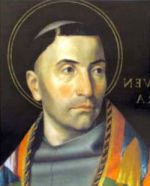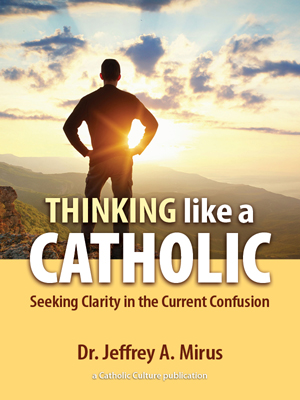After Much Study, a Miracle
The evening after the death of Padre Pio of Pietrelcina, September 23, 1968, the Capuchin Postulator, General Father Bernardino da Siena, traveled to San Giovanni Rotondo to venerate the body of the Capuchin friar. He impressed by the enormous crowds of faithful who flocked to the monastery, praying fervently and filing past Padre Pio's bier, a clear sign of the reputation for saintliness Padre Pio had enjoyed during his lifetime — and now continued to enjoy in death. At that moment, the Postulator began to consider beatification for Padre Pio.
The regulations in force at the time did not indicate any specific interval before initiating a beatification process, except for the outside limit of 30 years after the candidate's death. Father Bernardino, however, prudently decided to wait five years to ascertain whether Padre Pio's renown for holiness would grow or diminish.
In the meantime, the media, observing that no beatification cause had been promoted for the friar, began a campaign against the Catholic Church and the Capuchin Order, alleging that both institutions had persecuted Padre Pio during his life and claiming that this was now continuing after his death.
To put an end to such rumors, the Postulator General immediately announced the start of an official Church process. Having obtained the agreement of his superiors, on November 9, 1969, Father Bernardino da Siena submitted the formal request for beatification to the Apostolic Administrator of Manfredonia-Vieste and Bishop of Lucera, Msgr. Antonio Cunial, according to the regulations set forth in the Motu Proprio Sanctitas Clarior.
The bishop accepted the beatification request enthusiastically and immediately solicited written and sworn testimonials from those who had known Padre Pio during his lifetime. The office of Postulation also went to work, collecting the candidate's writings and preparing a thorough critical biography. The new Archbishop of Manfredonia-Vieste, Msgr. Valentine Vailati, was determined to make Padre Pio's beatification a top priority, and requested the regional episcopal conference's appointment of two censors to examine the friar's writings.
In 1973, the first presentation was submitted to the Congregation for the Causes of Saints. The documentation was pronounced insufficient. Thereafter, the beatification cause proceeded slowly and cautiously until, in 1980, the Postulation submitted a second presentation of texts, testimonials, documentation and research, which the Congregation agreed to examine.
And thus on November 29, 1982, the Congregation for the Causes of Saints granted the Archbishop of Manfredonia-Vieste the Nihil Obstat to initiate Padre Pio's beatification process. As soon as he received the communication, Msgr. Valentine Vailati appointed a tribunal and historical commission and, on March 20, in the Church of S. Maria delle Grazie at San Giovanni Rotondo, he officially opened the investigation into the life and virtues of Padre Pio of Pietrelcina.
Of the 74 witnesses presented by the Postulation, 69 were heard by the tribunal. Four did not appear, although they were invited. One was prohibited from testifying by his superiors. Upon its own initiative, the tribunal heard, ex officio, two other important deponents: Msgr. Gerolamo Bertignon, Bishop of Padua, and Msgr. Carlo Maccari, Archbishop of Ancona-Osimo. The other witnesses included bishops, Padre Pio's fellow friars, secular priests, other religious, and laypersons. The hearings took three years. The historical committee's research required even more time.
Finally, on January 21, 1990, the diocesan investigation was officially closed, once again in the Church of S. Maria delle Grazie at San Giovanni Rotondo.
The oral testimonials and the written documentation were gathered into 104 volumes and delivered to the Congregation for the Causes of Saints on February 13, 1990. The validity of Padre Pio's case was ascertained by the Congregation, which on December 7 of the same year appointed as official Relator the Reverend Father Cristoforo Bove, OFM.
The second phase of the beatification process began with the publication of the procedural acts. Once the fact of Padre Pio's "exemplary life" had been accepted (Positio Super Virtutibus), the next phase began: establishing the candidate's "heroic virtues," which are usually proven by some type of miraculous intervention.
At the ordinary session of the Special Congress of Theological Consultants on October 21, 1991, Msgr. Andrea Maria Erba, Bishop of Velletri-Segni and Deponent for Padre Pio's case, along with the member cardinals and bishops, announced the judgment: that Padre Pio had exercised the theological and other virtues in a "heroic" manner. The verdict was published in a decree promulgated by Pope John Paul II on December 18 of the same year.
Afterwards, the beatification itinerary continued with the Postulation's presentation to the Congregation for the Causes of Saints of a particular miraculous healing attributed to the intercession of Padre Pio. Towards the end of October 1995, Signora Consiglia De Martino, a married woman with three children who lived in Salerno, Italy, had been nursing her uncle who then passed away. On October 31, Consiglia was at the home of her widowed aunt, when she began to feel a heavy pain in her chest and stomach, as if her insides were being torn away. She felt a malaise throughout her body, chills and a sense of suffocation. She went to bed without supper and remained sleepless the entire night.
The next day, in spite of persisting pain, Consiglia did her usual housework and even accompanied her daughter Daniela to school. Afterwards she was on her way to Mass when she felt increasingly ill and stopped instead at her sister's home. There she experienced a painful swelling in her neck, and looking in the mirror perceived a lump as large as a grapefruit. Consiglia and her sister were quite frightened and called their husbands to accompany them to the Riuniti Hospital in Salerno. Consiglia was examined by the doctor on duty and immediately sent to the emergency room. A first CAT-scan revealed a liquid deposit on the left side of the neck. After a second CAT-scan the doctors diagnosed a diffuse lymphatic spilling of approximately two litres caused by a rupture of the lymphatic canals. A surgical intervention was advised, but meanwhile no form of therapy was applied.
Signora Consiglia De Matino and her family were very devoted to the figure of Padre Pio. Consiglia was a member of one of Padre Pio's prayer groups and was accustomed to appealing to Padre Pio in times of trouble; she also made monthly pilgrimages to San Giovanni Rotondo to pray at his tomb.
And so on November 1, 1995, as soon as she was brought to the hospital, Signora Consiglia turned to Padre Pio. She took her mobile phone and called Fra (Brother) Modestino Fucci at San Giovanni Rotondo to solicit prayers. Almost at the same time Consiglia's husband and daughter also called Fra Modestino to ask him to say some prayers. Later Fra Modestino confirmed that he had received those calls and that he had indeed prayed at Padre Pio's tomb for Signora Consiglia's recovery. Fra Modestino was sure his requests would be heard because Padre Pio had promised him as much during their time together at the monastery.
On the afternoon of November 2 there was a reduction in the fluid deposit in Consiglia's neck and the patient also experienced a marked diminution of pain. The health workers who examined her on November 3 noticed the almost complete disappearance of the swelling in her neck. An abdominal X-ray and examination showed no more evidence of unusual liquid in the system. Another CAT-scan on November 6 confirmed the complete disappearance of the liquid deposits.
The patient was dismissed with a clean bill of health soon after. Successive examinations revealed no after-effects of the illness.
The diocesan investigation of the miraculous healing took place at the Salerno Curia from July 24, 1996 to June 27, 1997, and with its decree of September 26, 1997, accepted the validity of the cure. The acts were then published and the documentation was studied by two experts ex officio and then by a medical consultant. On April 30, 1998, these experts unanimously announced the "extraordinary and scientifically inexplicable" nature of Signora Consiglia's cure.
On June 22, 1998, the Special Congress of Theologians was convened to discuss the theological aspects of the healing, and on October 20, the Ordinary Session of Cardinals and Bishops also met. On December 21, in the presence of Pope John Paul II, the Congregation for the Causes of Saints published the decree on Padre Pio's miracle. • © Inside the Vatican, Martin de Porres Lay Dominican Community, 3050 Gap Knob Road, New Hope, KY 40052, 800-789-9494.
This item 1018 digitally provided courtesy of CatholicCulture.org






